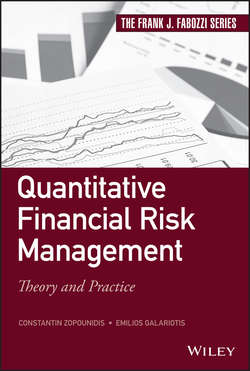Quantitative Financial Risk Management

Реклама. ООО «ЛитРес», ИНН: 7719571260.
Оглавление
Galariotis Emilios. Quantitative Financial Risk Management
The Frank J. Fabozzi Series
Preface
About the Editors
Section One. Supervisory Risk Management
Chapter 1. Measuring Systemic Risk: Structural Approaches
Systemic Risk: Definitions
From Structural Models to Systemic Risk
Measuring Systemic Risk
Systemic Risk and Copula Models
Conclusions
References
Chapter 2. Supervisory Requirements and Expectations for Portfolio-Level Counterparty Credit Risk Measurement and Management
Introduction
Review of the Literature
Supervisory Requirements for CCR
Conceptual Issues in CCR: Risk versus Uncertainty
Conclusions
References
Chapter 3. Nonperforming Loans in the Bank Production Technology
Introduction
Selective Literature Review
Method
Empirical Application
Summary and Conclusion
Appendix 3.1 Bank Names and Type
References
Section Two. Risk Models and Measures
Chapter 4. A Practical Guide to Regime Switching in Financial Economics
A Brief Look at Markov Regime Switching in Academic Economics and Finance
Regime Switching and Interest Rate Processes
Regime Switching and Exchange Rates
Regime Switching, Stock Returns, and Asset Allocation
Single-Asset Markov Models
Two-State Estimation
Three-State Estimation
Markov Models for Multiple Assets
Practical Application of Regime Switching Models for Investment Purposes
Intuitive Appeal of Such Models
Implementation Challenges
Selecting the “Right” Model Structure
Calibrating the Selected Model Type to Suitable Data
Drawing the Right Conclusions from the Model
References
Chapter 5. Output Analysis and Stress Testing for Risk Constrained Portfolios
Introduction
Worst-Case Analysis
Stress Testing via Contamination
Conclusions and New Problems
References
Chapter 6. Risk Measures and Management in the Energy Sector
Introduction
Uncertainty Characterization via Scenarios
Measures of Risks
Case Studies
Summary
References
Section Three. Portfolio Management
Chapter 7. Portfolio Optimization: Theory and Practice
Static Portfolio Theory
Importance of Means
Stochastic Programming Approach to Asset Liability Management
Siemens InnoALM Pension Fund Model
Dynamic Portfolio Theory and Practice: The Kelly Capital Growth Approach
Transactions Costs
Some Great Investors
Appendix 7.1: Estimating Utility Functions and Risk Aversion
References
Chapter 8. Portfolio Optimization and Transaction Costs
Introduction
Literature Review on Transaction Costs
An LP Computable Risk Measure: The semi-MAD
Modeling Transaction Costs
Non-Unique Minimum Risk Portfolio
Experimental Analysis
Conclusions
Appendix
References
Chapter 9. Statistical Properties and Tests of Efficient Frontier Portfolios
Introduction
Notation and Setup
Distribution of Portfolio Weights
Empirical Study
Discussion and Concluding Remarks
References
Section Four. Credit Risk Modelling
Chapter 10. Stress Testing for Portfolio Credit Risk: Supervisory Expectations and Practices
Introduction and Motivation
Conceptual Issues in Stress Testing: Risk versus Uncertainty
The Function of Stress Testing
Supervisory Requirements and Expectations
Empirical Methodology: A Simple ST Example
Conclusion and Future Directions
References
Chapter 11. A Critique of Credit Risk Models with Evidence from Mid-Cap Firms
Introduction
Summary of Credit Model Methodologies
Our Empirical Methodology
Critique
Conclusions
References
Chapter 12. Predicting Credit Ratings Using a Robust Multicriteria Approach
Introduction
Credit Scoring and Rating
Multicriteria Methodology
Empirical Analysis
Conclusions and Future Perspectives
References
Section Five. Financial Markets
Chapter 13. Parameter Analysis of the VPIN (Volume-Synchronized Probability of Informed Trading) Metric
Introduction
Definition of VPIN
Computational Cost
Optimization of FPR
Uncertainty Quantification (UQ)
Conclusion
References
Chapter 14. Covariance Specification Tests for Multivariate GARCH Models1
Introduction
Covariance Specification Tests
Application of Covariance Specification Tests
Empirical Findings and Discussion
Conclusion
References
Chapter 15. Accounting Information in the Prediction of Securities Class Actions
Introduction
Literature Review
Methodology
Data
Results
Conclusions
References
About the Contributors
Chris Adcock
David E. Allen
Vassiliki Balla
Marida Bertocchi
Iain Clacher
Jitka Dupačová
Mark Freeman
Hirofumi Fukuyama
Rosella Giacometti
David Hillier
Michael Jacobs JR., Ph.D., CFA
Malcolm Kemp
Miloš Kopa
Gregory Koutmos
Raimund M. Kovacevic
Renata Mansini
Wlodzimierz Ogryczak
Georg Ch. Pflug
Robert J. Powell
Horst D. Simon
Abhay K. Singh
Jung Heon Song
M. Grazia Speranza
Maria Teresa Vespucci
William L. Weber
Kesheng Wu
Qi Zhang
William T. Ziemba
Constantin Zopounidis
Glossary
Отрывок из книги
Quantitative Financial Risk Management
Theory and Practice
.....
That is, the conditional value at risk at level is compared to the conditional value at risk at the median level. From all the values, it is possible to construct another kind of dependency matrix.
This idea can also be applied to the system as a whole: If is replaced by the distance to default of the whole system, (1.16) to (1.18), leads to a quantity that measures the impact of entity i on the system. In this way one is able to analyze notions like “too big to fail” or “too interconnected to fail.”
.....